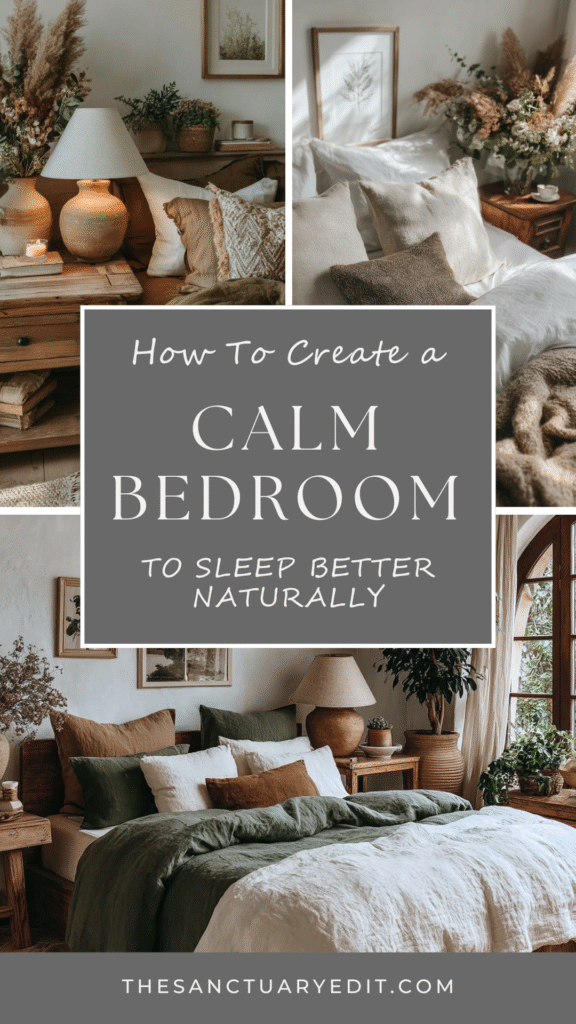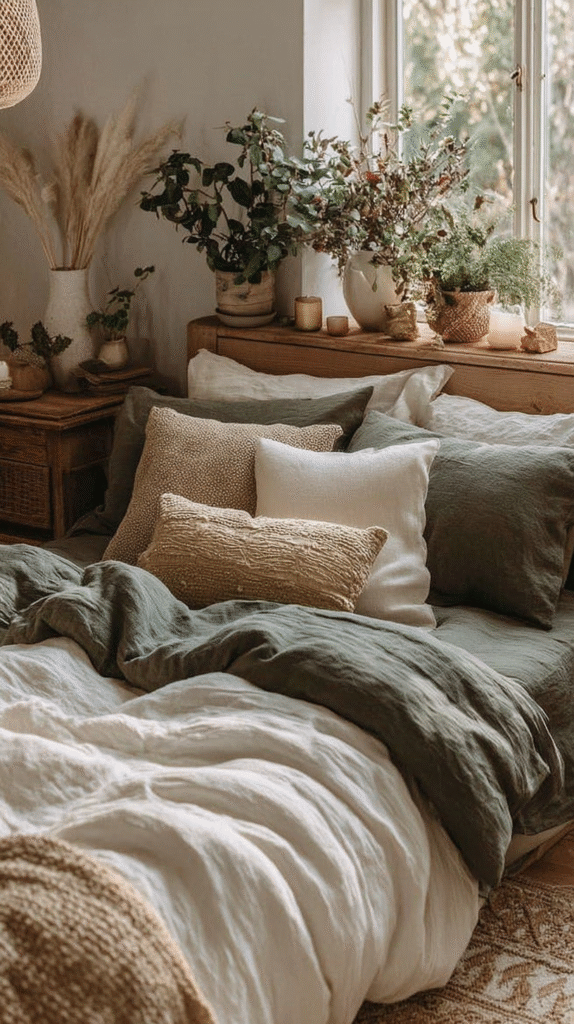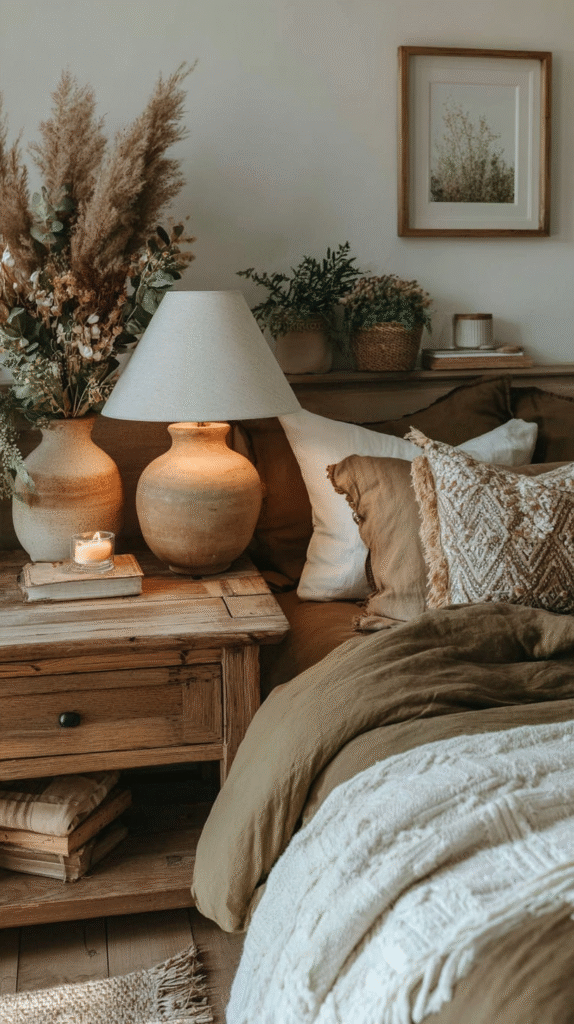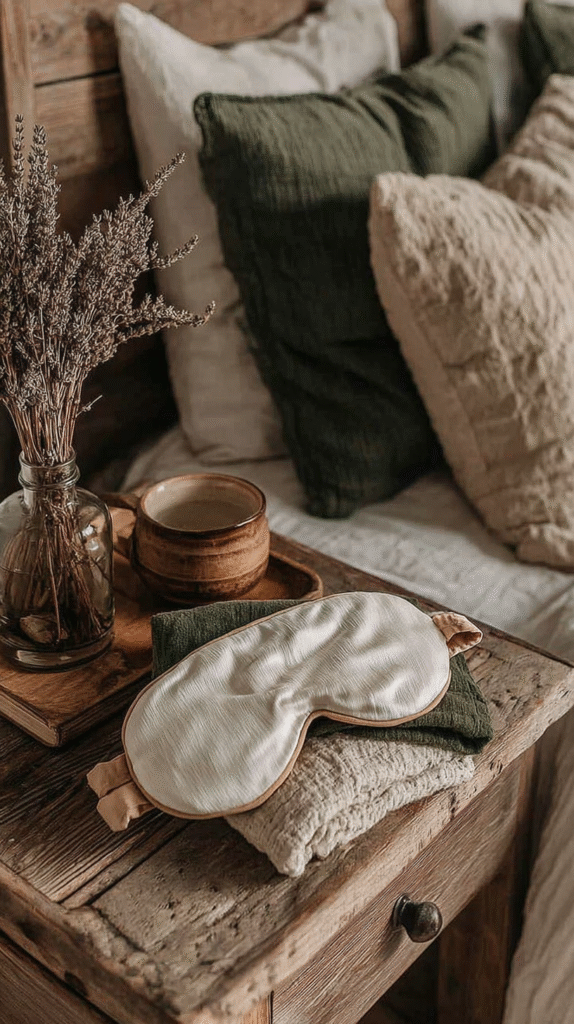This post may contain affiliate links, including those from Amazon Associates. If you make a purchase through these links, I may earn a commission at no additional cost to you. Learn more about our affiliate policy.
Sleep is one of the most powerful ways the body restores itself, yet it is also one of the most elusive when stress, overstimulation, or discomfort follow us into the night.
Your bedroom has the potential to either soothe or disrupt your nervous system.
By choosing natural elements like the materials, scents, and small sensory details, you can shape your space into a true sanctuary for rest.
These ten natural essentials invite comfort, calm, and gentle regulation. They are not complicated or prescriptive. Think of them as layers of support that help your body remember what it already knows: how to fall into deep, nourishing sleep.

Breathable, Natural Bedding
The foundation of restful sleep often begins with what touches your skin.
Bedding made from natural fibers like cotton, linen, or wool helps regulate temperature, wick away moisture, and feel soft without heaviness. Unlike synthetic fabrics, which can trap heat or irritate the skin, natural fibers breathe with you through the night.
Consider sheets in muted, calming tones that reflect the quiet mood of your room.
A linen duvet in a soft neutral or a lightweight cotton quilt can both create comfort while allowing air to circulate. The tactile feel of these fabrics can soothe the senses before you even close your eyes.
Natural Mattress Toppers
Even if your mattress isn’t perfectly suited to your body, a topper made from natural materials can transform your sleep.
Wool, cotton, and natural latex offer cushioning while remaining breathable and supportive. They create a buffer that adapts to your body’s shape and temperature, helping you feel held without overheating.
When you lie down at the end of the day, the subtle give of a natural topper can feel like an exhale, an invitation to let your muscles soften and your nervous system release.
Minimalist Futons and Floor Beds

For those who are drawn to simplicity, traditional futons made with cotton or wool offer a pared-back approach to sleep.
These natural, breathable layers support the spine and encourage a closer connection to the ground, which many find grounding and calming.
Floor beds or futons remind us that comfort does not have to come from excess.
They create a minimal sleep space that feels both spacious and serene, allowing the body to settle without the clutter of excess furniture or synthetic materials.
Horsehair and Other Natural Fillings
While less common today, horsehair and other traditional natural fillings have been used for centuries in bedding for their breathability and durability.
Hollow fibers allow air to circulate, creating a surface that feels cool and dry.
These kinds of natural fillings embody the wisdom of older traditions that are simple, lasting, and in harmony with the body.
Even if you never use horsehair itself, the idea reminds us to seek breathable, time-honored materials over synthetic substitutes.
Sleep–Wake Light

Light is one of the strongest signals to your nervous system.
Bright screens and harsh overhead bulbs at night can keep your body alert long after you want to rest. In contrast, soft, warm light tells your body it is time to let go.
In the evening, dim the lamps, use candles, or switch to bulbs that mimic the golden tones of dusk.
In the morning, expose yourself to natural light as early as possible. If your room does not allow this, consider a sunrise-simulating lamp that gently brightens, aligning your body with a natural rhythm.
These simple shifts help regulate your circadian clock and allow sleep to come more easily. You may also want to consider painting your bedroom walls a calming color to help your body shift into a restful state.
Calming Scents and Bedroom Plants
Scent has a direct line to the nervous system. Certain natural aromas, such as lavender, chamomile, and cedarwood, are known for their calming properties.
A few drops of essential oil in a diffuser, a spritz of linen spray on your pillow, or a sachet tucked near your bed can create a sensory cue that it is time to rest.
Living plants add another dimension. A lavender plant by the window or a pot of calming greenery adds not only scent but also the subtle grounding presence of nature in your space.
Plants remind us of breath and cycles, both of which support the body in winding down. For more ideas for easy indoor plants read my post here.
Weighted Silk or Cotton Eye Masks

Darkness tells the body that it is safe to sleep.
An eye mask made from silk or cotton can block out light while adding a gentle sensory weight across the eyes. Some are filled with calming herbs or lightly weighted to help you feel anchored.
This simple addition can create a cocoon-like effect, especially if your bedroom faces city lights or early morning sun.
It tells your nervous system that it is safe to release into darkness.
Breathable, Comfortable Sleepwear
The clothes you wear to bed can either add to your comfort or create irritation.
Choose natural fabrics like cotton, linen, or bamboo, which allow your skin to breathe and prevent overheating. Loose, soft shapes help the body move freely and keep you from feeling restricted.
More than comfort, bedtime clothing can serve as a ritual cue. Changing into calming, breathable sleepwear signals to your body that the day is closing, and rest is beginning.
Noise-Masking Tools and Quiet Atmosphere
Noise is one of the most common disruptions to sleep. Even subtle sounds like neighbors’ voices or a passing car, can jolt your nervous system into alertness. Creating a quiet bedroom environment helps your body feel safe enough to rest deeply.
If silence feels hard to achieve, soft white noise or gentle natural sounds can create a steady backdrop that masks interruptions.
The hum of a fan, the sound of rain, or a low white noise machine can transform your room into a cocoon of calm. The key is consistency because your body will begin to associate this steady sound with safety and sleep.
Evening Ritual Oils and Comforting Textures
Finally, think of the small sensory details that help you transition into rest.
A drop of oil massaged into your temples or chest. A throw made of wool or alpaca that you keep folded at the end of the bed. A soft rug underfoot as you move into bed.
These tactile and aromatic cues matter more than we often realize. They tell the nervous system, in ways beyond words, that it is safe to release.
Ritual oils like clary sage or bergamot can calm racing thoughts, while a favorite blanket creates a familiar layer of comfort. These small details are what make a bedroom feel not only functional but truly nurturing.
Weaving the Essentials Together
You don’t need to change everything at once. Begin with one or two essentials that feel easiest to integrate. Perhaps you start with natural bedding and a calming scent. Over time, you can add a candlelit evening ritual or a lavender eye mask.
What matters most is not perfection but the overall atmosphere you create. A bedroom layered with natural textures, soothing scents, and gentle cues becomes more than a place to sleep, it becomes a sanctuary where your nervous system can truly rest.
Closing Encouragement
Your body knows how to sleep. Often what it needs is simply a space that feels safe, calm, and uncluttered. By choosing natural materials, soft light, grounding scents, and gentle rituals, you create an environment that allows rest to arrive without force.
Sleep doesn’t always come the moment we ask it to, but shaping your bedroom as a natural sanctuary will make it easier for your body to remember its own rhythm.
Start with one essential. Layer slowly. Let each choice bring you closer to the kind of nights where rest feels effortless and mornings begin with clarity.


